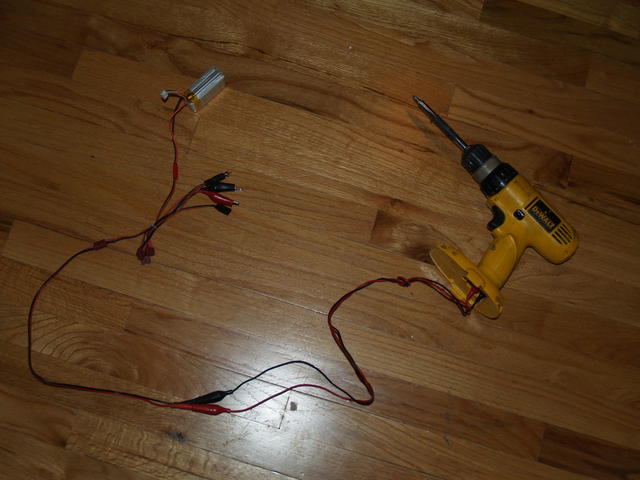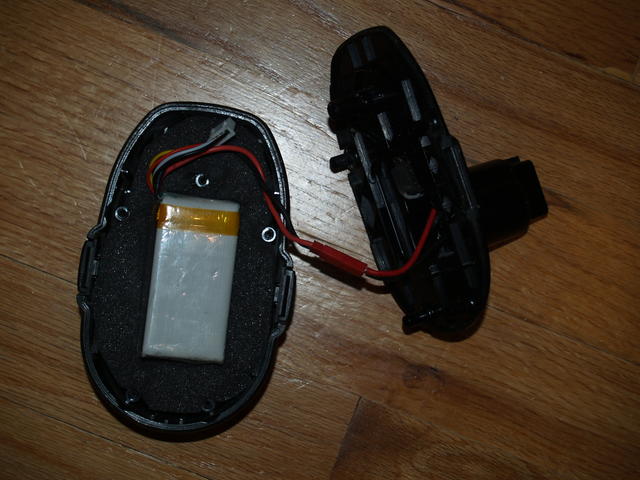Replacing NiCd power tool batteries with RC LIPO's
Posted by Admin • Wednesday, December 31. 2008 • Category: Hardware HacksThen I thought about LIPO cells... Let's see - 18V, that'd be a 5 cell (18.5V)... Well, for a test, I figured I'd try what I have around, and what I have around are 3 cell packs.

I took some measurements (these are all starting at 12.60V - a fully charged 3 cell LIPO):
Performance
- Momentary peaks at full stall:15A
- Sustained free full speed: 1.3A
- Continuous normal load: 3-10A
- Weight of original NiCd pack: 750g
- Weight of assembled LiPo pack: 255g (1lb lighter!)
- Estimated capacity with 1300mah battery - at least 1/3 original (this is a small pack and original I think is 3.4Ah)
This doesn't look too bad, and while I know that I have an 18V drill (because bigger is better, right?), its behaviour at 12V is actually quite acceptable. I thought for a while about the issues with this conversion, and then decided to just do the bare minimum and see. Here are the steps I took:
Procedure
- Opened the battery pack (you'll need a Torx type bit (a star), but a small screwdriver may work too)
- Removed and recycled the spent Sub-C NiCd cells (the top one actually physically supports the power connector)
- Kept the connector and soldered some 16Gauge wire to it instead, then glued the connector into the end of the pack cover (where it normally goes). Since no battery is supporting it now, Gorilla Glue will do the job from now on. Note: front lead is positive
- Since I have a few 10C RC battery packs I am going to use, I soldered a JST connector to the wires so I can just plug it in. I'd rather use Deans plugs but all my stuff is JST for now
- Just for fun, I made a little foam cutout to keep the battery safe in the case... the pack is small, the housing is huge
- If I wanted to keep the LIPO in this pack permanently (I will use mine for RC as well), I'd stick the balance plug out through a hole and screw this thing together at this point, to be charged via the terminals on top

Issues
Yes there are issues with this plan:- You cannot, ever, stick this pack into the Dewalt charger (it will likely overcharge the LIPO and set it on fire. Yes, big fire). Lipo packs should also be balanced, ideally, and for that I have my Mystery B6 charger
- Charging the battery requires opening the housing. This turned out to be OK - if you don't put the screws back in, the clips that hold the pack to the drill also keep the housing closed! Moreover, as I mentioned - if I wanted to dedicate a LIPO to this task permanently, I'd make a hole for the balance plug and close this up, then charge using alligator clips (they come with the B6). Update: I bought a 3 cell balance connector extension cable and left the end dangling out of the back for ease of use
- There is no LVC (low-voltage-cutoff). Lithium batteries have a minimum safe voltage - drain them below and you may have an exploding fireball in your hand (or just a damaged battery). For LIPO cells, minimum voltage is 3V (some people prefer 3.3V), and with my 3 cell pack, that means 9V to the drill when I should stop drilling. At 9V it will probably still be chugging along quite nicely, seeing how well an 18V drill runs at 12V.... I have some ideas on how to solve this, but they are not finished. An actual LVC device would be ideal. On Ebay, you can find low voltage alarms for 2-3 cell packs, and they provide LED's and a buzzer for exactly the right condition... the problem with this is two fold:
- You have to plug the balance connector of the battery into the device.
- The device will drain your pack if you forget to unplug it
There are, naturally, possible solutions:- Put a power switch on the pack (becomes even more complex and less elegant)
- Put the alarm in the drill itself (this doesn't work since the alarm unit needs the balancing plug, not main power plug. However, if we had an overall voltage alarm...)
- Find some other device for this purpose, such as an overall voltage alarm (9.9V alarm?)
- Just don't use the thing too much between charges

- Drain Rate Maximum should be observed. I have 10C LIPO batteries (maximum drain is 10 times capacity), so my 1300mAh pack should never be asked for more than 13A on a sustained basis. I think that's probably just within the limit there. Most people in RC nowadays seem to have 20C or higher anyway, so it's unlikely to scare anybody
All in all, I'm happy to have use of my drill again. I'll see how this works out and may update this if anything unexpected happens.
Update 2012
I used my drill this way for about 3 years. "This way" means telling everyone that they must stop using it the second it feels like it's slowing down. In the end, I used the drill to mix concrete with a paint mixer, which worked very well but towards the end the battery suddenly leaked out through the pack casing all over my hands. I can only guess that ignition was possible at that time but didn't happen. So, if you do this, you have to be careful.After that experience I bought a low speed drill for concrete (Harbor Freight, not a DeWalt).


Excellent. I am about to do the same.
I understand that the only risk of the battery voltage falling below 9V is perminant damage to the Lipo battery. How does that lead to fire?